Call today to schedule a free estimate with our exterminator.
Below is some information about pests found in the Rochester NY area.

Honey Bee Colonies have three castes: a queen, hundreds of drones, and from 30,000 to 50,000 workers.
Honey Bee Colonies are established not by a queen, as in most bees, but by groups known as swarms, which consist of a mated queen and a large contingent of worker bees.
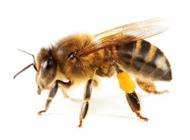
Africanized Honey Bees Guard the hive aggressively, with a larger danger zone around the hive than normal honey bees.
Compared to European honey bees, 3 to 4 times as many Africanized bees will be sent to defend the nest.
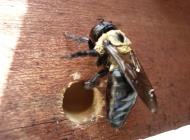
Carpenter Bees build individual nests in which they lay eggs but do not form colonies or hives like honey bees.
Males Carpenter Bees can be aggressive when defending their nest, but do not have stingers.
Female Carpenter Bees build nests by biting into wood and leave sawdust piles with near perfectly round holes in the wood.
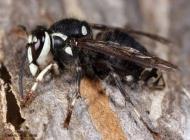
Bald-faced hornets are aggressive and will attack anyone or anything that invades their space.

Wasps/Hornets have smooth stingers, so they can sting over and over again.

Never kill a wasp near the nest. A dying wasp releases an pheromone, or smell, that alerts the other wasps. Within 15 seconds, wasps in a 15 foot radius will come to the victim's aid, you don't want to be there!
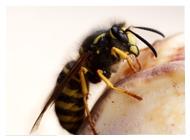
Yellow jackets are often called "bees" as they are similar in size and appearance, but are actually wasps.
Yellow jackets often make their nests in the walls of your home. When the nest gets large enough, they will break through the wall and invade your home.
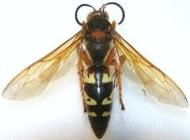
Adult eastern cicada killer wasps are large, 1.5cm to 5.0cm (0.6 to 2.0 in) long.
Coloration may resemble that of yellowjackets or hornets.
The females are larger than the males, and are among the largest wasps seen in the Eastern United States.
Below is some information about pests found in the Rochester NY area.
Bees / Wasps / Hornets
Honey Bees

Honey Bee Colonies have three castes: a queen, hundreds of drones, and from 30,000 to 50,000 workers.
Honey Bee Colonies are established not by a queen, as in most bees, but by groups known as swarms, which consist of a mated queen and a large contingent of worker bees.
Africanized Honey Bees

Africanized Honey Bees Guard the hive aggressively, with a larger danger zone around the hive than normal honey bees.
Compared to European honey bees, 3 to 4 times as many Africanized bees will be sent to defend the nest.
Carpenter Bees

Carpenter Bees build individual nests in which they lay eggs but do not form colonies or hives like honey bees.
Males Carpenter Bees can be aggressive when defending their nest, but do not have stingers.
Female Carpenter Bees build nests by biting into wood and leave sawdust piles with near perfectly round holes in the wood.
Bald Faced Hornet

Bald-faced hornets are aggressive and will attack anyone or anything that invades their space.
European Hornet

Wasps/Hornets have smooth stingers, so they can sting over and over again.
Wasp

Never kill a wasp near the nest. A dying wasp releases an pheromone, or smell, that alerts the other wasps. Within 15 seconds, wasps in a 15 foot radius will come to the victim's aid, you don't want to be there!
Yellow Jacket (Wasp)

Yellow jackets are often called "bees" as they are similar in size and appearance, but are actually wasps.
Yellow jackets often make their nests in the walls of your home. When the nest gets large enough, they will break through the wall and invade your home.
Cicada Killer (Wasp)

Adult eastern cicada killer wasps are large, 1.5cm to 5.0cm (0.6 to 2.0 in) long.
Coloration may resemble that of yellowjackets or hornets.
The females are larger than the males, and are among the largest wasps seen in the Eastern United States.



